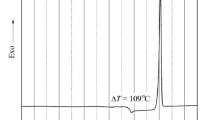Abstract
The temperature–concentration dependence of the electrical conductivity of glasses in the Li2O–LiPO3 and Li2S–LiPO3 systems is investigated. With the use of the Tubandt method, it is demonstrated that the electric current in glasses of these systems is provided by migration of lithium ions. The concentration dependence of the electrical conductivity is interpreted using the obtained data on the IR absorption spectra, density, microhardness, ultrasonic velocity, etc. It is found that the electrical conductivity of glasses in the Li2S–LiPO3 system is more than 103 times higher than that in pure LiPO3. The observed increase in the electrical conductivity is explained by the formation of sulfur-containing polar structural–chemical groupings of the Li+[S–PO3/2] type, whose dissociation energy is lower than that of similar oxide polar structural fragments. This results in an increase in the number of lithium ions involved in the electricity transport due to an increase in the degree of dissociation of polar structural–chemical units.
Similar content being viewed by others
REFERENCES
Pronkin, A.A., Study in the Field of Physical Chemistry of Halide-Containing Glasses, Doctoral (Chem.) Dissertation, Leningrad: Leningrad Technological Institute, 1979.
Myuller, R.L., Elektroprovodnost' stekloobraznykh veshchestv (Electrical Conductivity of Vitreous Compounds), Leningrad: Leningr. Gos. Univ., 1968.
Ravaine, D., Glasses for Electrochemical Devices, in Stekloobraznoe sostoyanie(The Vitreous State), Leningrad: Nauka, 1983, pp. 180–188.
Button, D.P., Tandon, R.F., Tuller, H.L., and Uhlman, D.R., Fast Li+ Ion Conductance in Chloroborate Glasses: II. Diborate and Metaborates, Solid State Ionics, 1981, vol. 5, part I, pp. 685–688.
Pronkin, A.A., Naraev, V.N., Tsoi Tong Bin, and Eliseev, S.Yu., Electrical Conductivity of Fluorine-and Chlorine-Containing Sodium Borate Glasses, Fiz. Khim. Stekla, 1992, vol. 18, no. 3, pp. 52–63 [Vov. J. Glass Phys. Chem. (Engl. transl.), 1992, vol. 18, no. 3, pp. 304–309].
Barrou, B., Ribes, M., Ravaine, D., and Satour, I.M., Synthese et etude des propertites electriques de nouveaux verres a conductivite ionique eleves, Silicate Ind., 1979, vol. 44, no. 12, pp. 275–281.
Barroy, B., Ribes, M., Maurm, M., et al., Glass Formation Region, Structure and Ionic Conduction in the Na2S-GeS2 System, J. Non-Cryst. Solids, 1980, vol. 37, no. 1, pp. 1–14.
Maluqani, I.P., Fanys, B., Mercier, R., et al., De nouveaux verres conducteurs l'ion lithium et leurs applications des generateurs electrochimiques, J. Solid State Ionics, 1983, vols. 9–10, no. 1, pp. 659–665.
Zaretskaya, G.N., Pronkin, A.A., and Il'in, A.A., Physicochemical Properties of Glasses in the Na2O-Na2S-P2O5 System, Fiz. Khim. Stekla, 1987, vol. 13, no. 3, pp.–464–467.
Baud, G. and Besse, I.P., Superionic Conducting Glasses; Glass Formation and Conductivity in the System AgPO3-Ag2S, J. Am. Ceram. Soc., 1981, vol. 64, no. 4, pp. 242–244.
Handbuch der prüaparativen anorganischen Chemie, Brauer, G., Ed., Stuttgart: Ferdinand Enke, 1954, vol. 2. Translated under the title Rukovodstvo po neorganicheskomu sintezu, Moscow: Mir, 1985.
Pronkin, A.A., Murin, I.V., Sokolov, I.A., Ustinov, Yu.N., and Loseva, M.N., Physicochemical Properties of Glasses in the Li2O-P2O5 System, Fiz. Khim. Stekla, 1997, vol. 23, no. 5, pp. 547–554 [Glass Phys. Chem. (Engl. transl.), 1997, vol. 23, no. 5, pp. 383–388].
Mamontova, T.N., Muranov, Kn.K., Vinogradova, G.Z., et al., A Study of Optical Properties and Photoluminescence of Glasses in the Ca-P-S System, Phys. Status Solidi A, 1986, vol. 93, no. 2, pp. 635–648.
Van Ass, H.M.I.M and Stevels, I.M., The Influence of Dissolved Heavy Water on the Internal Friction of Lithium Metaphosphate Glasses Containing 1% Potassium Metaphosphate,J. Non-Cryst. Solids, 1974, vol. 16, no. 2, pp. 161–170.
Martin, S.W. and Angell, C.A., DC and AC Conductivity in Wide Composition Range Li2O-P2O5 Glasses, J. Non-Cryst. Solids, 1986, vol. 83, pp. 185–207.
Al-Rihabi Hamman, A. and Souquet, I.L., Conductivity electrique de mataphosphats vitreux et cristallises, C. R. Acad. Sci., 1979, vol. 288, no. 23, pp. 549–552.
Ravaine, D., Glasses as Solid Electrolytes, J. Non-Cryst. Solids, 1980, vols. 38–39, pp. 353–358.
Mazurin, O.V., Strel'tsina, M.V., and Shvaiko-Shvaikovskaya, T.P., Svoistva stekol i stekloobrazuyushchikh rasplavov: Spravochnik (A Handbook on the Properties of Glasses and Glass-Forming Melts), Leningrad: Nauka, 1987, vol. 5.
Kanchieva, O.N., Komarova, N.V., Nemilov, S.V., and Tagantsev, D.K., Effect of Water Content on the Viscosity of Vitreous Na2O · 2SiO2, PbO · 2B2O3, and CaO · P2O5, Fiz. Khim. Stekla, 1980, vol. 6, no. 4, pp. 408–414.
Author information
Authors and Affiliations
Rights and permissions
About this article
Cite this article
Sokolov, I.A., Il'in, A.A., Tarlakov, Y.P. et al. Structure and Physicochemical Properties of Glasses in the Li2S–LiPO3 System. Glass Physics and Chemistry 29, 282–290 (2003). https://doi.org/10.1023/A:1024438200216
Issue Date:
DOI: https://doi.org/10.1023/A:1024438200216




